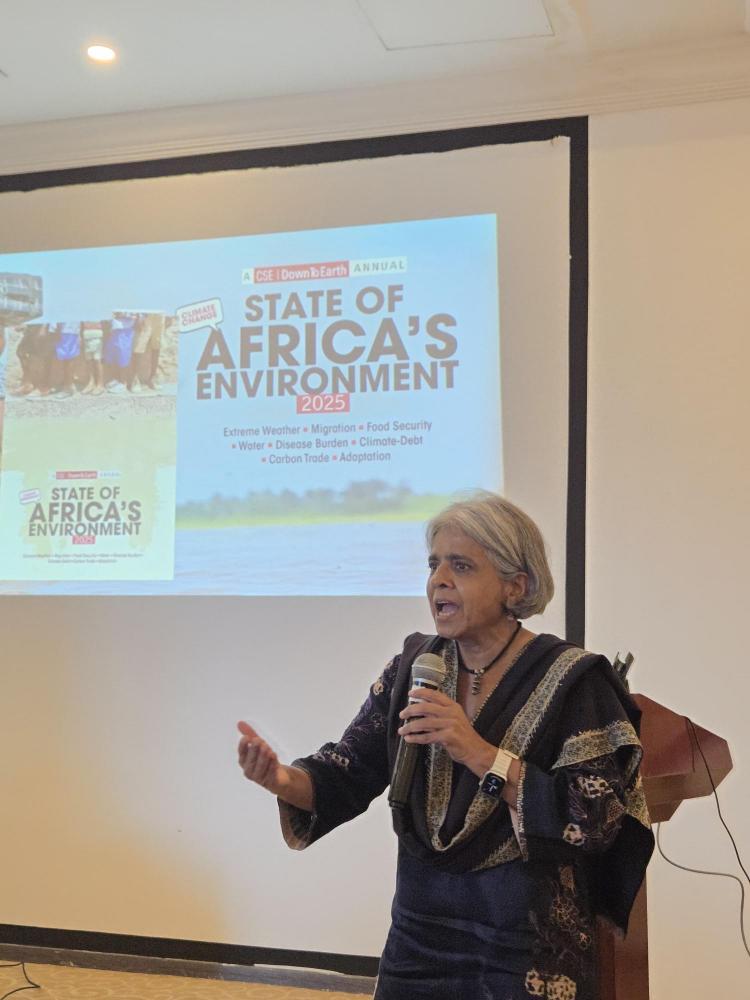 Sunita Narain, director general and a co-author of
the 'State of Africa’s Environment 2025 report' /AGATHA NGOTHO
Sunita Narain, director general and a co-author of
the 'State of Africa’s Environment 2025 report' /AGATHA NGOTHOAfrica is warming nearly twice as fast as the rest of the world, experts have warned.
The soil in Runyu, Kisumu, and Kitui is cracking. Rivers that once sustained crops are drying up, while elsewhere swollen floods wash away entire fields. Across Kenya, farmers are feeling the sting of a continent heating nearly twice as fast as the rest of the world.
The State of Africa’s Environment 2025 report warns that the climate crisis is dismantling livelihoods, driving families from rural areas and reshaping the future of food. Agriculture is the hardest hit, with smallholder farmers carrying the heaviest burden of both extreme weather and skewed global trade systems.
“For
small-scale farmers, who form the bulk of Kenya’s agricultural workforce, these
shocks are catastrophic,” Sunita Narain, an environmentalist and one of the
report’s authors, says. “Farmers are already living on the edge of subsistence.
When a drought or flood strikes, they are the first to suffer.”
Migration and the food paradox
The report links climate change directly to migration. Families are abandoning parched or flooded farms for cities, while others are risking journeys beyond Kenya’s borders. It highlights a paradox: Africa holds 60 per cent of the world’s uncultivated arable land, yet the continent remains a net food importer.
Kenyan farmers, in particular, face a double bind. Unpredictable weather devastates crops, while cheap food imports undercut their earnings. “The real conversation around climate-smart agriculture must go beyond yields,” Narain says. “It must ensure farmers get a better deal, that their crops are not undercut, and that they can thrive in their own markets.”
Cassava: Crop of contradictions
Among the crops highlighted is cassava, long considered Africa’s survival staple. It thrives with little water, requires minimal fertiliser and feeds families from root to leaf. But climate change is making it more vulnerable to pests and diseases.
“Cassava symbolises both resilience and vulnerability,” Narain says. “Productivity should be measured not only by yield, but also by how little input a crop requires to provide maximum nutrition.”
Soil beneath our feet
The report urges policymakers to look downwards—into the soil. For decades, agricultural policies have focused on what grows above ground, neglecting the complex ecosystems below. Heavy reliance on chemical fertilisers, it warns, has degraded soil health rather than restored it.
Healthy soils, rich in carbon, bacteria and fungi, are the bedrock of sustainable farming. “If farmers invest in soil health through organic carbon and biodiversity, they can increase yields without expensive chemical inputs,” Narain says.
For Kenya, where food prices are soaring and poverty remains widespread, soil regeneration is no longer optional.
Trapped by global trade
Beyond climate, Kenyan farmers are also hemmed in by global trade rules. Africa continues to export raw coffee, tea and cocoa, but when countries try to export finished products, they face punishing tariffs.
“Ghana pays zero tariffs when exporting raw cocoa, but up to 30 percent when exporting chocolate,” Narain notes. “It’s the same with coffee.” Such barriers lock African farmers into the least profitable part of the value chain, denying them funds that could cushion against climate shocks.
Path to resilient growth
The report calls for a new approach: one that blends climate-smart agriculture, soil regeneration, protection of indigenous crops like cassava and fairer trade rules. Growth, Narain argues, must be pursued in a way that strengthens resilience while protecting the environment.
“This is now the revenge of nature,” she warns. “For too long, we have abused it. The challenge for Kenya is to deepen economic growth without destroying the planet, while ensuring farmers have more money in their pockets. That is the true path to resilience.”













